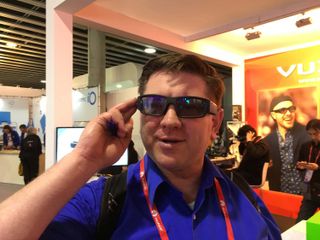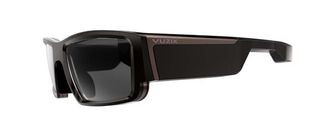Vuzix Readies Its Non-Doofus AR Glasses for Consumers
Vuzix's Blade 3000 specs look more like sunglasses than something that will get you mocked. They could be ready for consumers by 2018.
Since Paul Travers runs a company that makes augmented reality glasses, he's got his finger on one of the central problems keeping AR from gaining widespread acceptance among consumers.
"If you have something that makes you look like you've stepped off the Starship Enterprise, you're probably not going to want to wear it," the CEO of Vuzix tells me.

For most of Vuzix's customers, that's not really a concern. The company specializes in smart glasses, such as the M300 and M3000, that tackle business and industrial tasks, and if you're working in a warehouse or on a job site, who really cares what you look like, so long as you've got the equipment to get the job done?
It's quite a different matter out in the wild, though, where a civilian caught wearing a pair of AR glasses perfectly suited to an industrial setting might face unhealthy doses of ridicule. Just ask the poor souls who donned a pair of Google Glasses — if you can even get them to cop to it.
MORE: VR Mega Guide: Features and Release Dates
Vuzix thinks it might have just the set of AR glasses that regular folk would be happy to wear when they're out and about — the Blade 3000 Smart Sunglasses, which we spotted at last month's CES prior to this week's return engagement at Mobile World Congress.
From the sound of things, Vuzix seems confident about its AR glasses eventually winding up on the faces of consumers, with Travers suggesting this could be available for a consumer-friendly price tag in the neighborhood of $500 as soon as next year.
It's certainly not out of the realm of possibility. Vuzix's consumer-friendly glasses look less like a pair of AR spectacles and more like a particularly thick set of sunglasses. It's just the sort of thing an ordinary citizen might be tempted to wear, especially with all the AR power packed into the Blade 3000.

The left side of the glasses features an 8-megapixel camera. You can tap controls on the right side of the frame for the Android 5.0-powered glasses. You'll also find an accelerometer, gyroscope, magnetic-field sensor, and modules for Wi-Fi and Bluetooth — everything you'd find on a phone, save for the cellular connectivity.
That's a key point, since Travers sees the Blade 3000 as another argument for keeping your phone tucked away in your pocket. Why pull out the a smartphone to take a look at a notification when it can float up directly in front of your eyes on the Blade's 0.2-inch screen? You'll also be able to make a slight motion with your head to control the cursor.
But the biggest appeal beyond keeping your phone at bay will be the fact that the Blade 3000 glasses fit comfortably on your face. I've tried on my share of AR and VR headsets, and while the best of the bunch offer some impressive functionality, they're still pretty bulky to wear, especially all day.
Sign up to get the BEST of Tom’s Guide direct to your inbox.
Upgrade your life with a daily dose of the biggest tech news, lifestyle hacks and our curated analysis. Be the first to know about cutting-edge gadgets and the hottest deals.
While I only tried on Vuzix's glasses for a little bit, I never felt the weight of the Blade 3000 spectacles weighing down on the bridge of my nose. More important, even with augmented information like the weather floating up in my eye line, I felt as if I could still carry on a conversation with Travers without getting distracted by the floating data in the corner of my eye.
Chalk up the belief that Blade could go where Google Glasses failed to the Spectacles effect. With people clamoring to wear Snap's brightly colored camera-equipped glasses, Travers argues that it proves consumers don't necessarily need to sleek-looking wearables, but they do require something that looks like an actual person might wear them, especially if they pack in appealing functionality.
When my colleague Andrew E. Freedman talked to Vuzix about the Blade a month ago, the company was talking about selling its AR glasses for $1,000 to "prosumers." That's essentially still the plan, with Vuzix targeting the business-to-consumer market when the Blade 3000 arrives before year's end. But Travers thinks the glasses can have consumer appeal, particularly at a price of around $500.
The key, now that the aesthetic issue has more or less been settled, is coming up with apps that make a compelling use case for the Blade 3000. Travers talks about putting on the glasses at a football game and watching as the stats of the players float above them in augmented reality. Or imagine walking around a new city and using overlays visible through the glasses to learn about the history surrounding you.
And if it turns out you do use the Blade 3000 glasses for that purpose, at least you can be confident that no one will be pointing and laughing at the ridiculous thing you have on your face.
Philip Michaels is a Managing Editor at Tom's Guide. He's been covering personal technology since 1999 and was in the building when Steve Jobs showed off the iPhone for the first time. He's been evaluating smartphones since that first iPhone debuted in 2007, and he's been following phone carriers and smartphone plans since 2015. He has strong opinions about Apple, the Oakland Athletics, old movies and proper butchery techniques. Follow him at @PhilipMichaels.

